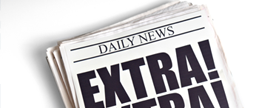lens
Forecasting What’s Next
A former Federal Reserve economist teaching on campus explains the forces at play
 Photo by Gus ChanMark Schweitzer
Photo by Gus ChanMark SchweitzerHave you checked the price of eggs lately? Noticed the rising cost of lumber? Heard that now’s the time to buy a new phone before prices jump? When there’s a new U.S. presidential administration, economic shifts may be on the horizon—but, too often, we focus on the headlines and our individual experience without fully understanding the broader economic forces at play.
Mark Schweitzer, PhD, an adjunct professor of economics at Case Western Reserve’s Weatherhead School of Management, can help make sense of it all. Previously a senior vice president and research director at the Federal Reserve Bank of Cleveland, he spent decades analyzing economic trends. Now, in the classroom, he teaches monetary policy, labor economics and macroeconomics.
Schweitzer spoke with Think in early April about the economy and what to expect in the months ahead.
What are the key factors involved in economic forecasting?
Forecasting starts with understanding the current state of the economy. At the end of last year, growth was stabilizing post-pandemic, the labor market was solid, and inflation, while not fully under control, was steadily declining.
The second factor is integrating new information, and right now, we don’t have much federal report data or other concrete information from the new administration to assess.
The third is evaluating risks to the outlook. One of the best approaches is considering a range of alternative forecasts. This allows us to evaluate potential outcomes for different versions of policies that may get implemented—like tariffs and immigration constraints.
How do tariffs affect businesses and consumers?
A tariff is a tax on imported goods. In economic models, we analyze whether sellers absorb some of that tax by lowering their prices or if it’s fully passed on to U.S. buyers. Historically, most of the cost has been borne by U.S. consumers.
Tariffs also prompt retaliatory measures from trading partners, raising costs for U.S. exports and reducing demand. Meanwhile, many U.S. products rely on imported components, which become more expensive. If consumers cut back on spending, demand drops, potentially leading to a recession.
Tariffs and restrictive immigration policies remain significant risks for the economy.
How does immigration affect the economy and what do you anticipate?
Since the pandemic recovery, unemployment has remained low, with only slight upticks as the Federal Reserve System worked to combat inflation. We don’t have a large surplus of available U.S. workers, and much of last year’s employment growth came from immigration.
If immigration slows or declines, employment growth will likely slow, reducing U.S. production capacity and overall economic growth.
How do current economic conditions differ for big businesses versus small ones?
We’ve seen broad economic growth benefiting both. Stock markets have favored large high-tech firms, but overall, growth has been strong. However, policy uncertainty remains a challenge.
In 2010, researchers developed an index measuring policy uncertainty, showing it negatively impacts businesses by making it harder to plan. Companies need clarity on factors like workforce availability, competitor actions and input costs. Without it, long-term investments become riskier, particularly for small businesses, which may delay hiring or expansion.
How do current economic conditions differ for big businesses versus small ones?
We started from a stable position, with a healthy, growing economy. That perspective often gets lost in fear-based public discourse.
That outlook is confronting real challenges—potential inflationary pressures from= factors like tariffs, for example, which have contributed to uncertainty and weakened business investment plans. My goal when I provide a forecast is to present the outlook and risks clearly and accurately without being overly alarmist.





